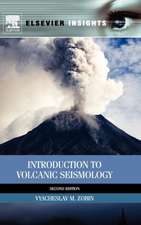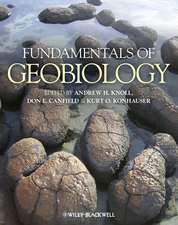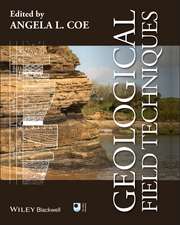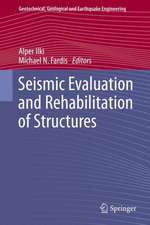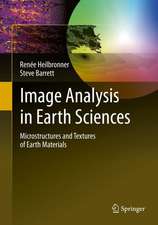Microearthquake Seismology and Seismotectonics of South Asia
Autor J.R. Kayalen Limba Engleză Hardback – 29 apr 2008
| Toate formatele și edițiile | Preț | Express |
|---|---|---|
| Paperback (1) | 1227.52 lei 6-8 săpt. | |
| SPRINGER NETHERLANDS – 19 oct 2010 | 1227.52 lei 6-8 săpt. | |
| Hardback (1) | 1238.74 lei 6-8 săpt. | |
| SPRINGER NETHERLANDS – 29 apr 2008 | 1238.74 lei 6-8 săpt. |
Preț: 1238.74 lei
Preț vechi: 1510.66 lei
-18% Nou
Puncte Express: 1858
Preț estimativ în valută:
237.06€ • 257.41$ • 199.13£
237.06€ • 257.41$ • 199.13£
Carte tipărită la comandă
Livrare economică 22 aprilie-06 mai
Preluare comenzi: 021 569.72.76
Specificații
ISBN-13: 9781402081798
ISBN-10: 1402081790
Pagini: 524
Ilustrații: XX, 503 p.
Dimensiuni: 155 x 235 x 33 mm
Greutate: 1.05 kg
Ediția:2008
Editura: SPRINGER NETHERLANDS
Colecția Springer
Locul publicării:Dordrecht, Netherlands
ISBN-10: 1402081790
Pagini: 524
Ilustrații: XX, 503 p.
Dimensiuni: 155 x 235 x 33 mm
Greutate: 1.05 kg
Ediția:2008
Editura: SPRINGER NETHERLANDS
Colecția Springer
Locul publicării:Dordrecht, Netherlands
Public țintă
ResearchCuprins
Earthquakes and Seismic Waves.- Microearthquake Recording and Data Analysis.- Dynamics of Faulting and Fault Plane Solution.- Himalayas, Pamir-Hindu Kush and Foredeep Region.- Northeast India, Myanmar, Bangladesh and Andaman-Sumatra Region.- Seismotectonics of Peninsular India and Sri Lanka.
Textul de pe ultima copertă
This volume is the outcome of about 30 years of research in the field of earthquake seismology in various parts of South Asia. It comprehensively deals with plate tectonics and seismic waves in general and earthquake monitoring by permanent and temporary networks for active fault mapping, aftershock, swarm and induced seismicity investigations in interplate collision and subduction zones and in intraplate shield region. Data acquisition as well as data analysis are well presented for clear understanding of interpretation with limitations of the techniques. State-of-the-art techniques in earthquake location/relocation, fault plane solution, waveform inversion, seismic tomography, fractals etc. are discussed, and the results are interpreted in terms of seismic source processes in the region.
A large quantity of seismic data in the Himalaya from western syntaxis, Pamir-Hindu Kush to western (Garhwal) Himalaya, central (Nepal) Himalaya, eastern (Sikkim and Bhutan) Himalaya to the eastern syntaxis and Arunachal Himalaya are analysed to understand seismotectonics of the Himalayan collision zone. The atypical continental plate (Indian continental plate) subduction beneath the Indo-Burma ranges and typical oceanic plate (Indian Oceanic plate) subduction beneath the Andaman-Sumatra arc in Southeast Asia are also examined with the available data. Temporary and permanent microearthquake network data in the peninsular India shield region and in Bangladesh and Sri Lanka shed light on the intraplate tectonics in South Asia.
"Professor Kayal is to be congratulated for this very compendium, which is firmly based on his more than 25 years experience as a microearthquake seismologist and researcher. The book will serve multiple readerships. It is a comprehensive and up-to-date textbook for students interested in field seismology. It also provides a synthesis of the seismotectonics and seismic hazard of the Indian subcontinent and India-Eurasia collision zone."
-Euan Smith, Professor of Geophysics, Victoria University of Wellington
"Dr. J.R. Kayal has been leading Geological Survey of India for over two decades in operating seismic stations in the complex Indian-Eurasian collision zone. Dr. Kayal has put together his vast experience in this useful book. This timely compilation addresses several aspects of microearthquake studies as well as their application to comprehending complex seismotectonics of South Asia. Dr. Kayal deserves compliments for this beautiful compilation."
-Prof. Harsh K. Gupta, Raja Ramanna Fellow, National Geophysical Research Institute, Hyderabad, India
"We normally hear of earthquakes in terms of the destruction that they cause. However, the study of microearthquakes serves a very practical purpose. It helps to define the seismotectonic framework which includes the determination of the stress field causing the earthquake, the geometry of the seismogenic faults and the style of faulting. These are essential parameters in both the assessment of seismic hazards and in the study of rectonics of the region. With illustrative examples from various seismotectonic regions in India, Dr. Kayal has written an excellent, hands-on book, for both the investigator and the user of these data."
-Pradeep Talwani, Professor of Geophysics and Director of the South Carolina Seismic Network, University of South Carolina, Columbia, SC, USA
A large quantity of seismic data in the Himalaya from western syntaxis, Pamir-Hindu Kush to western (Garhwal) Himalaya, central (Nepal) Himalaya, eastern (Sikkim and Bhutan) Himalaya to the eastern syntaxis and Arunachal Himalaya are analysed to understand seismotectonics of the Himalayan collision zone. The atypical continental plate (Indian continental plate) subduction beneath the Indo-Burma ranges and typical oceanic plate (Indian Oceanic plate) subduction beneath the Andaman-Sumatra arc in Southeast Asia are also examined with the available data. Temporary and permanent microearthquake network data in the peninsular India shield region and in Bangladesh and Sri Lanka shed light on the intraplate tectonics in South Asia.
"Professor Kayal is to be congratulated for this very compendium, which is firmly based on his more than 25 years experience as a microearthquake seismologist and researcher. The book will serve multiple readerships. It is a comprehensive and up-to-date textbook for students interested in field seismology. It also provides a synthesis of the seismotectonics and seismic hazard of the Indian subcontinent and India-Eurasia collision zone."
-Euan Smith, Professor of Geophysics, Victoria University of Wellington
"Dr. J.R. Kayal has been leading Geological Survey of India for over two decades in operating seismic stations in the complex Indian-Eurasian collision zone. Dr. Kayal has put together his vast experience in this useful book. This timely compilation addresses several aspects of microearthquake studies as well as their application to comprehending complex seismotectonics of South Asia. Dr. Kayal deserves compliments for this beautiful compilation."
-Prof. Harsh K. Gupta, Raja Ramanna Fellow, National Geophysical Research Institute, Hyderabad, India
"We normally hear of earthquakes in terms of the destruction that they cause. However, the study of microearthquakes serves a very practical purpose. It helps to define the seismotectonic framework which includes the determination of the stress field causing the earthquake, the geometry of the seismogenic faults and the style of faulting. These are essential parameters in both the assessment of seismic hazards and in the study of rectonics of the region. With illustrative examples from various seismotectonic regions in India, Dr. Kayal has written an excellent, hands-on book, for both the investigator and the user of these data."
-Pradeep Talwani, Professor of Geophysics and Director of the South Carolina Seismic Network, University of South Carolina, Columbia, SC, USA
Caracteristici
Covers topics ranging from basics of plate tectonics, seismology, data acquisition, seismogram analysis to use of software for earthquake locations, relocations, fault plane solutions, seismic tomography, fractals and waveform modeling Illustrates seismotectonics/ models in different tectonic zones in the 2500 km long Himalayan arc, 2000 km long Indo-Burma-Sumatra arc and in the stable continental region of the Indian subcontinent including peninsular India, Bangladesh and Sri Lanka A large data set from the permanent and temporary seismograph networks and aftershock data of recent large earthquakes in the region is used to image crustal structure and the seismogenic sources Review of huge contributions and researches done on geophysics, geology and seismology in the past and present contributions by different National and International Seismological Projects and Workshops in South Asia region are made Topics like seismic hazard, paleoseismology, earthquake precursor, induced seismicity, tsunamis are also dealt with by field examples



